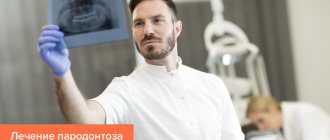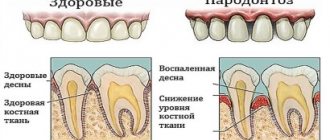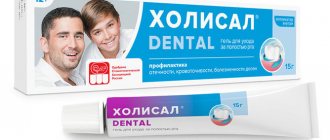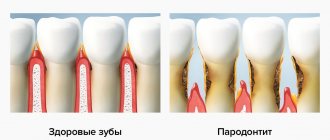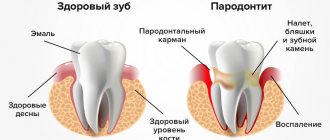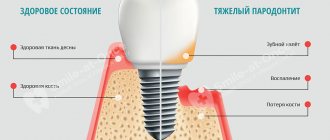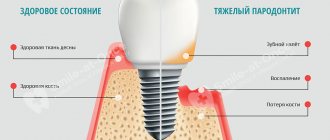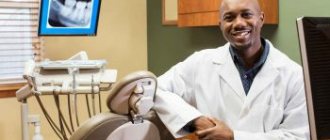From this article you will learn:
- What is the difference between periodontal disease and periodontitis?
- causes and symptoms of its development,
- how to treat periodontal disease at the dentist, as well as home therapy products.
The article was written by a dentist with more than 19 years of experience.
Periodontal disease is a disease of the gums, which is based on the process of sclerosis of blood vessels, which leads to a decrease in the supply of oxygen and nutrients, and as a result, there is a slow degeneration of all periodontal tissues (i.e., the bone tissue around the tooth, periodontal fibers attaching the tooth to bones, as well as soft tissues of the gums).
Typically, patients incorrectly use the term “periodontal disease” to refer to any existing gum disease. In fact, periodontal disease is a fairly rare disease, and most patients who complain about problems in the gums do not have periodontal disease, but actual chronic generalized periodontitis.
Periodontal disease: photos of teeth and gums
You can very easily check whether you have periodontitis or periodontal disease - the symptoms of the latter are a gradual decrease in the height of the gums and exposure of the roots of the teeth, which occurs due to the gradual process of sclerosis and dystrophy - usually in the absence of any inflammation in the gums. In turn, the presence of bleeding and soreness of the gums when brushing, swelling and redness of the gums indicates the presence of inflammation in the gums, i.e. about Periodontitis.
Introduction
The information world is very huge. Each of us is haunted by a million points of view
for any problem in any field of knowledge, you just need to ask a search query. The same thing happens in medical circles on the Internet - discussions of health problems are widely represented by both patients and doctors and often reach the point of absurdity:
For example, in questions:
- loosening of the tooth,
- exposure of the neck of the tooth,
- why are my gums and teeth exposed?
that is, in situations where the gums on a tooth have receded, patients are always confused: they have periodontal disease
, then suddenly it changed to
periodontitis
, then periodontal disease returned again. And the search for an answer to the question becomes endless.
The problem of “how to treat periodontal disease” is picked up by doctors who only add fuel to the fire by recommending medications and even folk remedies for periodontal disease, without having sufficient competence to do so.
Let's consider these points of view professionally, and try to convey one simple truth, which for the vast majority of patients (and even some doctors) will be a revelation: the diagnosis of periodontal disease of the gums
» —
does not exist
.
An expert point of view is expressed by the famous periodontist, Doctor of Medical Sciences Laura Mikhailovna Tebloeva:
As a rule, for patients who come to me and say: “I have periodontal disease,” I always clarify - did you make this diagnosis yourself or did you see a doctor? Often patients answer that they have this information from their doctor. It turns out that the patient did not read somewhere and determine the diagnosis of “periodontal disease” for himself, but, unfortunately, such a diagnosis was made by a doctor.
Massage and gymnastics
Gum massage can be considered as an excellent aid that increases blood flow and lymph movement. Usually carried out after injections in order to quickly absorb the injected drug.
The massage is performed manually in the direction from the center of the jaw to its edges, or using a special apparatus. The procedure can be carried out independently, combined with the active rubbing of ready-made preparations - ointments or gels. The procedure stimulates blood circulation well and helps relieve discomfort such as pain or itching in the gums.
To avoid further injury to the gums and loosening of the teeth, massage is carried out with careful movements of the fingers, with minimal pressure.
Important. Before you prescribe a massage for yourself, be sure to consult with your doctor. This will avoid unnecessary complications. Moreover, at a certain stage, gum massage will be contraindicated.
Always treat gum problems
When a patient comes to the doctor, he complains about something. What symptoms does he see a doctor with before receiving a diagnosis of periodontal disease? What worries him?
Literally, patients tell the doctor this: my gums have sagged, my gums have become exposed, my lower gums have receded. And for some reason the symptom of gum subsidence automatically means that the patient has the so-called. periodontal disease.
More experienced patients, who have already heard a lot of professional terms, who delve into the professional colloquial language of doctors, say this: “The necks of the teeth have become exposed a little, the teeth have become a little higher.” But, according to statistics, most patients complain about sagging gums.
And so, when patients come to the doctor with complaints about the problem of exposed tooth necks, the doctor diagnoses them with periodontal disease. Of course, he begins to treat them. And to treat it specifically for periodontal disease.
But time passes, money also goes away, and the question of why the gums recede and the necks of the teeth become exposed, why the gums recede, has not been resolved. And the patient still has periodontal disease.
Active chewing
To strengthen the periodontium and improve the condition of the gums, you can try chewing 3-4 times a day. The duration of the procedure is about 10 minutes. Active chewing has an additional massaging effect and causes increased blood circulation in the gums.
What you can use:
- thin oak or spruce twig;
- plantain leaves;
- crushed pine needles;
- sauerkraut.
Chewing should begin with careful movements of the teeth left and right. You can resort to active movements only after strengthening your teeth. Unfortunately, it is not recommended to chew nuts and crackers.
What tactics are used to treat periodontal disease?
I want to start with the fact that patients who come with a diagnosis of periodontal disease, they need, every single one, treatment... not from the periodontist to whom they initially turned.
If we talk about the tactics of managing patients with the so-called. periodontal disease, which then come to me again, it’s a shame to voice this, but the treatment of periodontal disease was carried out right up to injections of Lincomycin into the exposed gum.
According to statistics, almost always the treatment of periodontal disease in adults with medications is burdened with a course of some antibiotics and physical therapy.
And most importantly, the task of all these manipulations is completely unclear: what do doctors want to achieve in this way, to destroy some kind of flora or to stop some destructive processes in the gums? It is very difficult for me to say what happens to the competence of a doctor who injects antibiotics for the so-called. periodontal disease, but this is absolute blasphemy. Is it possible to cure periodontal disease by destroying the flora? As a result, the gums will never recover.
Treatment of gum periodontal disease reaches the point of absurdity
I would like to note the widest range of drugs and folk remedies that patients use to attempt self-treatment of periodontal disease at home. Among the folk remedies, one can note the treatment of periodontal disease with hydrogen peroxide, and even treatment with soda:
What about the use of various toothpastes for periodontal disease? What goals do patients have? The purpose of toothpaste is preventative, not curative. And no toothpaste will eliminate inflammation, because there is no such inflammation in periodontal disease.
It is not difficult to guess that in these combinations of procedures the question of how to cure periodontal disease remains open.
Rinses
If there are foci of inflammation in the oral cavity, the doctor prescribes rinsing with a 0.05% chlorhexidine solution in combination with subsequent treatment of the gums with cholisal gel.
The procedure will look like this:
- brushing teeth after breakfast;
- rinse your mouth for one minute with chlorhexidine solution;
- drying the gums with a gauze pad (you can breathe through your mouth);
- applying applications with cholisal gel.
The procedure is carried out twice a day for ten days. It is not recommended to eat for two to three hours after rinsing.
You can also use ready-made Asepta, which contains chlorhexidine and benzydamine. The drug quickly relieves pain, reduces swelling and inflammation.
There is no inflammation with periodontal disease
When does the so-called periodontal disease, there is no inflammatory process in the gums. The clinical picture of “periodontal disease” differs sharply from periodontitis; it is with periodontitis of the tooth that inflammation occurs.
And injections into the gums, endless restorations of the necks of the gums - this is running in circles. Over time, again all the restoration fillings are chipped, and again these patients come to have these fillings restored again. And this happens endlessly
:
And the diagnosis of “periodontal disease” does not go away. As Desna ran away, she continues to leave. The fillings increase, that is, the teeth increase in size, because the gums sag more and more, and nothing useful happens.
When such a patient gets an appointment with me, unwinding his entire tangle of ordeals during the consultation, it becomes clear that all previously performed gum treatment consists of 3
factors:
- Lost time,
- lost money
- shattered hopes.
The diagnosis was incorrect and the treatment was appropriate for the incorrect diagnosis. What went wrong?
Patients should always go for a consultation with such a diagnosis... to an orthodontist
.
Because periodontal disease is an occlusal injury
.
What I see in these patients with signs of periodontal disease is a completely different diagnosis. This is an occlusal injury that can only be corrected by an orthodontist.
Clinical researches
According to the results of the clinical use of the Asepta line of products: the examined patients, already at the first follow-up examination (after 1-2 days) of using the Asepta line of products, showed a decrease in complaints of discomfort in the gums. On examination, hyperemia and bleeding of the gingival papillae are noted. On the 7th day, complaints of gum bleeding persisted in a minority of patients.
Upon examination, a decrease in hyperemia and swelling of the gums was noted, but bleeding persisted upon probing. On day 14, 2 patients continued to complain of bleeding gums when brushing their teeth; upon examination, a significant decrease in hyperemia and swelling of the gums was noted. After the final application of the gel with propolis, normalization of clinical manifestations was revealed, which is manifested by the absence of bleeding during brushing and probing.
Improved dynamics of indicators allows us to recommend the Asepta line of products for the local treatment of inflammatory periodontal diseases.
Sources:
- Clinical experience in using the Asepta series of products Fuchs Elena Ivanovna Assistant of the Department of Therapeutic and Pediatric Dentistry State Budgetary Educational Institution of Higher Professional Education Ryazan State Medical University named after Academician I.P. Pavlova of the Ministry of Health and Social Development of the Russian Federation (GBOU VPO RyazSMU Ministry of Health and Social Development of Russia)
- The use of adhesive balm "Asepta®" in the treatment of inflammatory periodontal diseases L.Yu. OREKHOVA*, Dr. med. Sciences, Professor, Head of Department V.V. CHPP**, Dr. med. Sciences, Professor, Head of Department S.B. ULITOVSKY*, Dr. med. Sciences, Professor A.A. LEONTIEV*, dentist A.A. DOMORAD**, O.M. YAKOVLEV** SPbSMU named after. acad. I.P. Pavlova, St. Petersburg - *Department of Therapeutic Dentistry, **Department of Microbiology
- The use of new anti-inflammatory drugs in the complex of therapeutic and preventive measures for periodontal diseases (E.D. Kuchumova, A.A. Leontyev, O.V. Kalinina, L.Yu. Orekhova, S.B. Ulitovsky) E.D. Kuchumova, Ph.D., Associate Professor, A.A. Leontyev, dentist, O.V. Kalinina, dentist, L.Yu. Orekhova, Doctor of Medical Sciences, Professor, Head of Department, S.B. Ulitovsky, Doctor of Medical Sciences, Prof. Department of Therapeutic Dentistry of St. Petersburg State Medical University named after. acad. I.P. Pavlova
- Article “Treatment and hygiene features for mild and moderate periodontitis” by S.B. Ulitovsky head Department of PFS, Professor, Doctor of Medical Sciences, A.A. Leontyev Associate Professor of the Department of PFS, Ph.D. PSPbSMU named after. I.P. Pavlova
- Evaluation of the effectiveness of treatment of chronic generalized periodontitis of mild and moderate severity using Asepta antibacterial agents (S.I. Gazhva, A.I. Voronina) S.I. Gazhva, Doctor of Medical Sciences, Prof., Head of Department A.I. Voronina, aspirant, dentist, Department of Dentistry, Faculty of Dentistry, State Educational Institution of Higher Professional Education "Nizhny Novgorod State Medical Academy"
- Study of the clinical effectiveness of treatment and prophylactic agents of the Asepta line in the treatment of inflammatory periodontal diseases (A.I. Grudyanov, I.Yu. Aleksandrovskaya, V.Yu. Korzunina) A.I. GRUDYANOV, Doctor of Medical Sciences, Prof., Head of Department I.Yu. ALEXANDROVSKAYA, Ph.D. V.Yu. KORZUNINA, asp. Department of Periodontology, Central Research Institute of Dentistry and Maxillofacial Surgery, Rosmedtekhnologii, Moscow
What is occlusal injury
Occlusal trauma is when a tooth experiences excessive stress due to:
- the tooth is not in the dentition,
- the tooth is not in the correct position,
- the tooth has not grown physiologically,
- the tooth is tilted, at the wrong angle.
The occlusion of the teeth is impaired. That is, when chewing in a patient with impaired occlusion, a destructive force of chewing pressure is created, and the bone tissue in the area of these above teeth begins to decrease.
What is chewing from a physiological point of view?
It's teeth hitting teeth. The strongest blow, since the masticatory muscles are the strongest in the body.
In simple words, in a patient, from such a hyper-impact, hyper-contraction of the masticatory muscles, which develops during chewing, from this beating of teeth against each other, the bone begins to contract. Bone tissue shrinks. And after the bone, the gum also contracts, because the bone and gum are tightly connected. The gum descends, following the bone. And here we answered the main question - why gums recede.
Let's now begin to form an understanding of the answer to the next question: what to do if your gums have receded.
Complications
If periodontal disease is not treated, the disease will actively progress and lead to complete atrophy of the periodontal tissues. As a result, the teeth will gradually begin to become exposed, acquire a wedge-shaped shape, and begin to loosen. In this case, some of them will have to be removed.
This is not just about cosmetic defects. There is confirmed data from American scientists about the influence of periodontal disease on the development of diseases of the gastrointestinal tract, as well as on the occurrence of a number of cancers.
Orthodontics comes to the fore
Today, a huge mistake is happening both in the search for the causes of periodontal disease and in making a diagnosis, as well as in the method of effective treatment. Instead of putting the tooth into occlusion, removing it from a traumatic bite, patients are offered all these manipulations that I have previously voiced, which are not at all aimed at getting rid of these complaints, but only at the fact that patients are wasting time, the processes are getting worse.
In the treatment of the so-called periodontal disease is a big problem in the loss of time for inadequate treatment, and the loss of time for the patient is a complication of the pathology of dental occlusion, and the transition of the stage of the disease to a more advanced form.
If a patient, for example, three years ago had a loss of bone tissue of two millimeters, then due to the “treatment of periodontal disease” he has already lost five millimeters, that is, we have lost time.
And if he came to the orthodontist with a loss of bone tissue of two millimeters, then it would be easier to stop the loss of gums, it would be easier to eliminate the development of gum pathology after orthodontic treatment, when the teeth become aligned with the dentition.
We can already talk about the fact that we close all exposed necks of gum recession, thereby treating the neck of the tooth. But when patients waste time on treatments that are inadequate for the disease, sometimes closing the recession is no longer possible. Because there are also strict indications and contraindications for the treatment of gum recession.
Intervention by a surgeon or orthopedist
At an advanced stage of the disease, drastic measures are inevitable. In cases where drug and physiotherapeutic treatment no longer produce results, and degenerative processes continue to progress, the help of a surgeon and orthopedist is necessary.
The doctor removes the most problematic teeth and cleans out periodontal pockets. After this, the orthopedist begins work. In place of the removed teeth, prostheses are installed - metal-ceramic bridges or complete dentures. In case of fan-shaped divergence of teeth, splinting clasps are used to fix the teeth in the affected area.
Symptoms
Periodontal disease is an extremely rare disease. It is most often encountered by older people. The disease develops unnoticed: patients may not even be aware of it. Usually the pathology is discovered by a dentist during a routine examination.
Symptoms of periodontal disease are similar to those of other diseases:
- unpleasant odor;
- swelling of soft tissues;
- bleeding and pain of gums;
- reaction to sour, hot, cold;
- discharge of pus;
- taste of blood;
- tooth mobility.
